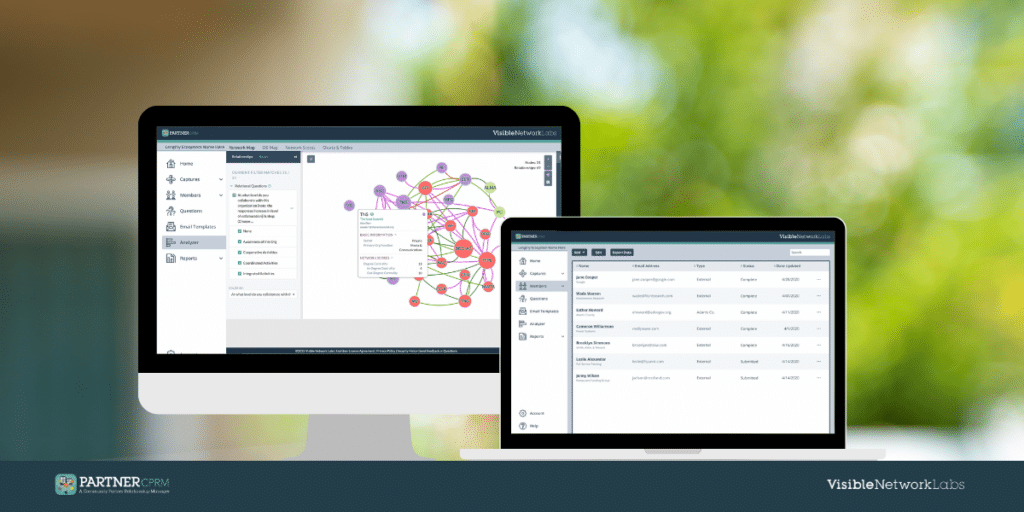Organizational Network Analysis (ONA) is a transformative approach that uncovers the relationships and dynamics within and between organizations. It provides invaluable insights into how information flows, how collaborative networks are structured, and where influential nodes lie.
This comprehensive guide, enriched by the principles and tools of Visible Network Labs and PARTNER CPRM, walks you through the process of conducting an ONA with depth and precision.
Table of Contents
Introduction to Organizational Network Analysis
ONA is a methodological approach that uses network science to visualize and analyze the patterns of relationships and interactions within an organization or across a network of organizations. It helps in identifying how these patterns influence behaviors, processes, and outcomes. By leveraging ONA, organizations can uncover hidden resources, optimize communication pathways, and foster collaboration.
What Questions Can ONA Answer?
Organizational Network Analysis (ONA) can help answer a wide range of questions related to the structure, dynamics, and effectiveness of networks within and between organizations. These questions can inform strategic decisions, operational improvements, and insights into organizational health. Here are some key questions ONA can address:
Who are the key influencers within the network?
- Identify individuals or organizations that hold central positions within the network and have the potential to influence others significantly.
How does information flow across the organization?
- Understand the pathways through which information travels, identifying potential bottlenecks or areas where information flow is optimal.
What are the subgroups or clusters within the network?
- Detect naturally forming groups or clusters within the network, which can reveal patterns of collaboration or division.
Where are the gaps or weaknesses in the network?
- Highlight areas where connections are lacking, which could represent opportunities for strategic relationship building or restructuring.
What is the impact of network structure on performance?
- Correlate network metrics with performance indicators to understand how the network’s structure influences organizational outcomes.
How are external stakeholders integrated into the network?
- Analyze the connections between internal and external entities to evaluate the organization’s openness and its ability to leverage external resources.
What potential partnerships could be developed?
- Identify opportunities for strategic alliances or partnerships based on complementary positions or needs within the network.
What are the dynamics of informal networks?
- Uncover the hidden structures of informal networks that often play a critical role in day-to-day operations but may not be reflected in formal organizational charts.

Step 1: Define Your Analysis Objectives
Clearly defining the purpose of your ONA is critical. Objectives can range from enhancing communication, fostering innovation, streamlining processes, or identifying key influencers and collaborators. A clear set of objectives will guide the design of your network study, the data collection methods, and the analysis approach.
Step 2: Plan Your Analysis Approach
Determine the scope of your network analysis. Will you focus on the entire organization, specific departments, or external networks? Decide whether an egocentric (focusing on the network from the perspective of individual nodes) or sociometric (analyzing the network as a whole) approach best serves your objectives. Consider factors such as the size of your network, the availability of data, and the complexity of relationships.
Step 3: Collect Data
Data collection is foundational to ONA. This involves identifying and gathering information on the nodes (individuals, departments, or organizations) and the ties (relationships or interactions) between them. Methods include surveys, interviews, analysis of digital communications (emails, social media interactions), and observation. Tools like PARTNER CPRM offer sophisticated survey builders and interaction capture features, streamlining the collection of relational data and ensuring a comprehensive understanding of your network’s dynamics.
Step 4: Map the Network
With data in hand, the next step is to create a visual representation of your network. This mapping process illuminates the structure of connections, highlighting key nodes, clusters, and potential bottlenecks. PARTNER CPRM facilitates advanced relationship mapping, allowing users to visualize the intricate web of interactions and identify central players and areas for intervention.
Step 5: Analyze the Network
Analysis involves interpreting the network map and metrics to draw insights relative to your objectives. Look for patterns of connectivity, centrality measures (identifying influencers), density (the overall connectedness), and subgroups or clusters within the network. PARTNER CPRM’s network analyzer tool can help in exploring these aspects, providing a deep dive into the network’s structure and dynamics, facilitating strategic decision-making.
Step 6: Interpret and Apply Findings
The insights gained from your analysis should be translated into actionable strategies. This could involve strengthening weak ties, leveraging influential nodes to disseminate information, or reconfiguring the network structure to enhance efficiency and innovation. PARTNER CPRM’s data-driven insights empower organizations to make informed decisions, fostering a strategic approach to collaboration and network management.
Step 7: Monitor and Adapt
Networks are dynamic entities. Regular monitoring and adaptation are essential for maintaining an optimal network structure. Implementing changes based on your analysis and tracking their impact over time allows for continuous improvement. PARTNER CPRM supports ongoing network management, enabling organizations to visualize changes, assess the effectiveness of interventions, and adapt strategies as necessary.

PARTNER CPRM: SNA Platform for Mapping Relationships & Influencers
PARTNER CPRM harnesses the power of SNA to revolutionize community partnership management. It offers a comprehensive platform for:
Integrating perceptions of influence alongside quantitative data.
Analyzing influence based on resource control or other attributes.
Employing advanced analytics to uncover structural indicators of influence.
Through real-world case studies, PARTNER CPRM demonstrates its efficacy in identifying key influencers across diverse communities, supporting effective collaboration and strategic decision-making.
Learn More: Request a Demo
To see the platform for yourself, request a demo below and meet with a network science expert who can answer all your questions and curiosities. We look forward to connecting and helping you take the next step together!

Tips for Conducting a Successful ONA
Conducting an Organizational Network Analysis (ONA) can yield transformative insights for organizations, aiding in the optimization of workflows, enhancement of communication, and fostering of innovation. However, for an ONA to be successful, it’s crucial to approach it thoughtfully and strategically. Here are several tips for conducting a successful ONA, along with common pitfalls to avoid:
Tips for a Successful ONA
Clearly Define Objectives: Before starting, have a clear understanding of what you hope to achieve with the ONA. This will guide your data collection, analysis, and the actionable insights you seek to derive.
Ensure Comprehensive Data Collection: Collect data that covers all relevant aspects of the network. This might include not just the connections but the strength, type, and frequency of interactions. Utilize tools like PARTNER CPRM for efficient data gathering and management.
Engage Stakeholders Early: Involve key stakeholders from the beginning to ensure their needs and concerns are addressed. Their buy-in is crucial for the implementation of any changes based on ONA findings.
Use the Right Tools: Leverage advanced network analysis tools that can handle the complexity of organizational networks. Tools with visual mapping, detailed analytics, and user-friendly interfaces can provide deeper insights and facilitate the interpretation of data.
Communicate Findings Effectively: Present your findings in a clear, actionable manner. Use visuals to illustrate network structures and highlight key insights. Tailor your communication to your audience to ensure the implications are understood and accepted.
Pitfalls to Avoid
Overlooking Data Privacy and Ethics: Always consider the ethical implications of collecting and analyzing network data. Ensure compliance with data protection laws and maintain the confidentiality of personal information.
Ignoring Contextual Factors: Networks don’t exist in a vacuum. Neglecting the organizational culture, external environment, or specific industry challenges can lead to misinterpretation of data.
Focusing Only on Central Nodes: While key influencers are important, overlooking peripheral nodes can miss opportunities for innovation or identify emerging talents and insights from less central individuals.
Data Overload: Collecting too much data or too many types of data can be overwhelming and counterproductive. Focus on data that directly relates to your objectives to avoid analysis paralysis.
Failing to Act on Insights: The value of ONA lies in applying its insights to make informed decisions. Not using the findings to effect change renders the exercise academic and not practically beneficial.
Underestimating the Need for Follow-Up: Networks evolve over time. A one-time analysis provides a snapshot but ongoing monitoring is essential for tracking changes and assessing the impact of interventions.
FAQ
Q: What is organizational network analysis?
A: Organizational Network Analysis (ONA) is a methodological approach used to visualize, analyze, and optimize the relationships and interactions within and between organizations. By mapping out the network of connections among individuals, departments, or entire organizations, ONA helps in identifying influencers, understanding information flows, and uncovering opportunities for improving collaboration and efficiency.
Q: How do you conduct an organizational network analysis?
A: Conducting an ONA involves several key steps:
- Define Objectives: Clearly articulate what you aim to achieve with the analysis.
- Plan the Analysis: Decide on the scope and the type of network analysis (egocentric or sociometric).
- Collect Data: Gather information on the entities within the network and the relationships between them using surveys, digital communication logs, or observation.
- Map the Network: Use the collected data to create a visual representation of the network.
- Analyze the Network: Examine the network map and metrics to identify patterns, key nodes, and insights.
- Implement Findings: Translate the insights into actionable strategies for organizational improvement.
Q: What is an example of organizational network analysis?
A: A healthcare system conducts an ONA to improve patient care coordination across its network. By mapping the interactions between different departments and external partners, they identify bottlenecks in information flow and collaboration gaps. Implementing the ONA’s insights, they restructure their communication processes and partnerships, leading to more efficient patient care and reduced operational costs.
Q: What do you mean by organizational network?
A: An organizational network refers to the complex web of relationships and interactions that occur within and between organizations. This includes formal and informal connections among employees, departments, and external entities such as partners, suppliers, and customers. Organizational networks can influence information flow, decision-making processes, and the overall performance and innovation capacity of an organization.
Q: What are some tools for organizational network analysis?
A: Several tools can facilitate ONA by providing capabilities for data collection, network mapping, and analysis. Examples include:
- PARTNER CPRM: Offers features for relationship mapping, survey building, and network analysis tailored to community partnership management.
- UCINET: A comprehensive tool for social network analysis that includes data management, statistical analysis, and visualization capabilities.
- Gephi: An open-source network visualization software that allows users to create dynamic and interactive network maps.
- NodeXL: An Excel template for network analysis and visualization, making it accessible for users familiar with Microsoft Excel.
- Kumu: A versatile tool for creating interactive network maps, ideal for visualizing complex relationships and systems.
These tools vary in their complexity, features, and areas of application, providing options for different needs and expertise levels in conducting organizational network analysis.

How to Conduct an Organizational Network Analysis (ONA)
Organizational Network Analysis is a powerful tool for understanding and optimizing the networks that underpin organizational effectiveness. Through a methodical approach to defining objectives, collecting and analyzing data, and applying insights, organizations can uncover the latent potential within their networks. Leveraging the capabilities of PARTNER CPRM enhances this process, offering a comprehensive suite of tools for mapping, analysis, and strategic network management.
By embedding ONA into their strategic planning, organizations can foster collaboration, drive innovation, and achieve superior outcomes, illustrating the profound impact of network science on organizational success.
Additional Resources
Looking for more information? Check out these websites and resources related to conducting an organizational network analysis.






